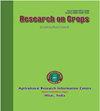Optimizing bioherbicide application timing and plant spacing to manage weed growth in rice (Oryza sativa L.) cultivation
Q3 Agricultural and Biological Sciences
引用次数: 0
Abstract
Weed management is crucial for successful rice cultivation. Bioherbicides derived from cogon grass extract offer a promising solution for weed control. Additionally, optimizing plant spacing has been recognized as an effective method to suppress weed growth. Thus, this study aims to investigate the impact of cogon grass extract application timing and plant spacing on weed growth in rice cultivation. The study was conducted from October 2022 to February 2023 in the Special Region of Yogyakarta, Indonesia. The study was 3 × 2 factorial and arranged in a randomized completely block design (RCBD). The first factor was the bioherbicide application timing: control (no application), three days before planting, and at the time of planting. The second factor was plant spacing: 15 × 15 and 25 × 25 cm. In total, there were six treatment combinations and three replications (replications as blocks). The research results indicated the application timing of bioherbicide did not significant effect on the growth of weed and rice, as well as the grain dry weight. Fimbristylis miliacea was obtained as the dominant weed species. Bioherbicide application at the time of planting could alter the composition of weed species compared to the control in plant spacing of 15 × 15 cm. Furthermore, the plant spacing of 25 × 25 cm resulted in higher grain and weed dry weight (19.40 g/clump and 45.00 g/0.25 m2) compared to 15 × 15 cm (12.92 g/clump and 23.04 g/0.25 m2). On the contrary, the grain dry weight per hectare was higher in 15 × 15 cm (5.74 t/ha) than in 25 × 25 cm (3.10 t/ha). The research findings indicate that closer plant spacing can suppress weed growth and increase the grain dry weight per hectare compared to wider plant spacing. We recommend that the use of cogon grass extract dosage needs to be increased above 50 L/ha.优化生物除草剂的施用时间和株距,管理水稻(Oryza sativa L.)种植中的杂草生长
杂草管理对水稻种植的成功至关重要。从豚草提取物中提取的生物除草剂为控制杂草提供了一种很有前景的解决方案。此外,优化株距也被认为是抑制杂草生长的有效方法。因此,本研究旨在调查香附子草提取物的施用时间和株距对水稻种植中杂草生长的影响。研究于 2022 年 10 月至 2023 年 2 月在印度尼西亚日惹特区进行。研究采用 3 × 2 的阶乘设计(RCBD)。第一个因素是生物除草剂的施用时间:对照(不施用)、种植前三天和种植时。第二个因素是株距:15 × 15 厘米和 25 × 25 厘米。总共有六个处理组合和三次重复(重复为块)。研究结果表明,施用生物除草剂的时间对杂草和水稻的生长以及谷物干重没有显著影响。杂草的主要种类是芒萁(Fimbristylis miliacea)。与株行距为 15 × 15 厘米的对照组相比,在播种时施用生物除草剂可改变杂草种类的组成。此外,与 15 × 15 厘米(12.92 克/丛和 23.04 克/0.25 平方米)相比,株行距为 25 × 25 厘米的谷物和杂草干重(19.40 克/丛和 45.00 克/0.25 平方米)更高。相反,15 × 15 厘米的每公顷谷物干重(5.74 吨/公顷)高于 25 × 25 厘米的每公顷谷物干重(3.10 吨/公顷)。研究结果表明,与较宽的株距相比,较近的株距可以抑制杂草生长,提高每公顷谷物干重。我们建议,豚草提取物的用量应增加到 50 升/公顷以上。
本文章由计算机程序翻译,如有差异,请以英文原文为准。
求助全文
约1分钟内获得全文
求助全文
来源期刊

Research on Crops
Agricultural and Biological Sciences-Soil Science
CiteScore
1.50
自引率
0.00%
发文量
93
审稿时长
1 months
期刊介绍:
The Research on Crops is a peer-reviewed journal publishing original research papers, review articles and short communications in English on all basic and applied aspects of crop sciences, agricultural water management, agro-climatology, agroforestry, agronomy, crop production, crop protection, cropping systems, food science & technology, genetics & plant breeding, horticulture, plant & soil science, plant biotechnology, plant nutrition, post-harvest management of crops, seed science, soil management & tillage, vegetables, weed science, agricultural engineering, agri-business, agricultural economics and extension, etc. The aim of the journal is to provide a forum for the scientific community to publish their latest research findings.
The manuscripts submitted for publication should not contain data older than 4 years on the date of submission.
The articles submitted for publication in this journal should not be submitted elsewhere simultaneously for publication in another journal. These should not carry any copyright material without prior permission of copyright holder.
The articles should present a complete picture of the investigation made and should not be split into parts.
There is no prescribed limit regarding the number of pages in case of full-length articles. However, the authors are advised to keep the length of their articles from 4 to 10 full printed pages of the journal.
The articles should be divided into the sub-sections: ABSTRACT, INTRODUCTION, MATERIALS AND METHODS, RESULTS AND DISCUSSION, CONCLUSIONS, and REFERENCES. Tables and figures should be appended separately at the end.
 求助内容:
求助内容: 应助结果提醒方式:
应助结果提醒方式:


